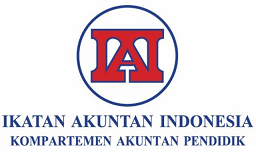INTERNET OF THINGS (IoT) DAN BLOCKCHAIN DALAM PERSPEKTIF AKUNTANSI
Abstract
Perkembangan pesat pada teknologi Internet of Things (IoT) dan Blockchain (BC) mendorong penelitian ini dalam mengusulkan dua aplikasi model transaksi IoT-BC dalam bidang akuntansi. Model transaksi IoT-BC dapat secara otomatis mengumpulkan, mengunggah, dan merekam semua data keuangan yang relevan dalam proses transaksi perusahaan untuk memenuhi asumsi tertentu. Model ini tidak memerlukan intervensi manual pada titik mana pun dalam proses; dan tidak ada data yang direkam pada buku besar dapat dirusak. Model transaksi IoT-BC dapat mengurangi asimetri informasi yang terjadi antara manajemen dan para shareholders. Metode penelitian ini menggunakan pendekatan kualitatif deskriptif. Penelitian ini menghasilkan penyediaan informasi akuntansi secara real-time untuk meningkatkan kegunaan informasi akuntansi secara substansial. Penelitian ini juga mengidentifikasi Teknologi IoT dan BC dapat secara signifikan meningkatkan relevansi, ketepatan waktu, keterbandingan, dan kualitas informasi akuntansi. Kesimpulan dari penelitian ini adalah dengan implementasi teknologi IoT dan BC, maka organisasi akan mampu meningkatkan kualitas informasi akuntansi dan dalam jangka panjang akan meningkatkan nilai perusahaan.
Downloads
References
Atlam, H. F., & Wills, G. B. (2019). Technical aspects of blockchain and IoT. In Advances in Computers (1st ed., Vol. 115). Elsevier Inc. https://doi.org/10.1016/bs.adcom.2018.10.006
Bonsón, E., & Bednárová, M. (2019). Blockchain and its implications for accounting and auditing. Meditari Accountancy Research, 27(5), 725–740. https://doi.org/10.1108/MEDAR-11-2018-0406
Creswell, J. . (2017). Research Design: Qualitative, Quantitative, and Mixed Methods Approaches (Third Edit). Sage Publications, Inc.
Dai, J., Wang, Y., & Vasarhelyi, M. A. (2017). Blockchain: An Emerging Solution for Fraud Prevention. The CPA Journal, 87(6), 12–14. http://esc-web.lib.cbs.dk/login?url=http://search.ebscohost.com/login.aspx?direct=true&db=bth&AN=123973389&site=ehost-live&scope=site
Deloitte. (2018). IoT powered by Blockchain: How Blockchains facilitate the application of digital twins in IoT. 20.
Faccia, A., & Mosteanu, N. (2019). Accounting and blockchain technology: from double-entry to triple-entry. 10(2), 108–116.
Gill, S. S., Tuli, S., Xu, M., Singh, I., Singh, K. V., Lindsay, D., Tuli, S., Smirnova, D., Singh, M., Jain, U., Pervaiz, H., Sehgal, B., Kaila, S. S., Misra, S., Aslanpour, M. S., Mehta, H., Stankovski, V., & Garraghan, P. (2019). Transformative effects of IoT, Blockchain and Artificial Intelligence on cloud computing: Evolution, vision, trends and open challenges. Internet of Things (Netherlands), 8(October), 1–30. https://doi.org/10.1016/j.iot.2019.100118
Nakamoto, S. (2008). Bitcoin: A peer-to-peer Electronic Cash System. Journal for General Philosophy of Science, 39(1), 53–67. https://doi.org/10.1007/s10838-008-9062-0
Neuman, W. L. (2014). Social Research Methods: Qualitative and Quantitative Approaches. Boston, USA: Pearson/Allyn and Bacon.
Pugna, I. B., & Duţescu, A. (2020). Blockchain – the accounting perspective. Proceedings of the International Conference on Business Excellence, 14(1), 214–224. https://doi.org/10.2478/picbe-2020-0020
Shi, P., Wang, H., Yang, S., Chen, C., & Yang, W. (2019). Blockchain‐based trusted data sharing among trusted stakeholders in IoT. Software: Practice and Experience, March, 1–14. https://doi.org/10.1002/spe.2739
Swamy, S. N., & Kota, S. R. (2020). An empirical study on system level aspects of Internet of Things (IoT). IEEE Access, 8, 188082–188134. https://doi.org/10.1109/ACCESS.2020.3029847
Swan, M. (2011). Blueprints for a new economy. In Nation (Vol. 293, Issue 11).
Szabo, N. (1997). Smart Contracts. http://www.fon.hum.uva.nl/rob/Courses/InformationInSpeech/CDROM/Literature/LOTwinterschool2006/szabo.best.vwh.net/smart.contracts.html
Van Horn, J. (2021). The Intersection of Accounting and Blockchain Technology: An Analysis of Current and Future Implications. May. https://scholarsbank.uoregon.edu/xmlui/handle/1794/26568
Yermack, D. (2017). Corporate governance and blockchains. Review of Finance, 21(1), 7–31. https://doi.org/10.1093/rof/rfw074

This work is licensed under a Creative Commons Attribution-NonCommercial-ShareAlike 4.0 International License.
Jurnal Akutansi dan Keuangan allows readers to read, download, copy, distribute, print, search, or link to the full texts of its articles and allow readers to use them for any other lawful purpose. The journal allows the author(s) to hold the copyright without restrictions. Finally, the journal allows the author(s) to retain publishing rights without restrictions
Authors are allowed to archive their submitted article in an open access repository
Authors are allowed to archive the final published article in an open access repository with an acknowledgment of its initial publication in this journal







